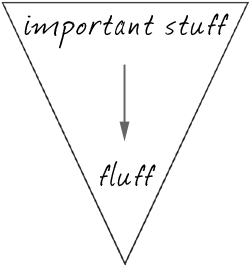
Here’s a tip from the newsroom: the inverted pyramid style of writing. It will help you to get your message across faster. It was developed by journalists for reasons that are completely irrelevant today… or are they?
The inverted pyramid principle says you should put your most important point at the top of the article, followed by your next most important point, and so on, in diminishing order of importance.

Newspapers still use this principle today, but where did it come from? Many historians say that the inverted pyramid was invented by 19th century wartime reporters, who sent their stories by telegraph. They wanted the most crucial information to get through first, just in case the transmission was interrupted.
But, you say, we don’t send many telegrams today. Ah, but more than ever, we do send messages that can easily be interrupted! Distraction, impatience, confusion, even boredom; all these can keep your reader from finishing those precious words that you’ve written. Busy people expect writers to get to the meat quickly, or they’ll find something else to read.
The next time you write something, decide what your most important point is. If they don’t hear anything else you say, what do you want them to hear? Then, say that first.

Al, good plugin. I agree that some blogs might fail to explain what they are about in the first few seconds a visitor gets there.
On those cases the plugin works well. What I try to do with my blogs it to choose a name-domain name combination that pretty much says it all. Like “Daily Writing Tips.”
Awesome tip! Couldn’t agree more.
wonderful ^&^
Another important thing: we should remember that space is premium in newspapers. The idea of the inverted pyramid is excellent for editors who can easily cut the less important details of your story without touching the important ones which you have already placed in the lead paragraph, i.e., to save more space for other important stories/articles.
Thanks so much for posting this tip. I think for a long-winded writer like me, this tip will come in very handy.
this has been one of the most and widely recommended for safe and effective writing technique in news writing and the like. moreover, this inverted pyramid style of writing helps determine the effectiveness and significance of the data to be presented in a certain article…
Thanks for the good work u guy are doing, it we go a long way to help the writers. am grateful
i am student of mass communication. i like your website and want to be your subscriber.
wow i accually think this could help people who have problems wiff this kinda stuff !!!! im a nith grader and i think this !!!!!!!!
Am a mass communication student in an open university but willing to specialize in ‘Advertising’,plz i need guiding tips from your blog,thx.
Journalism – writing about a fatal accident
this was surely informative.
Uh what is this?
“It was developed by journalists for reasons that are completely irrelevant today… or are they?”
Question writing, especially in the lead, is also frowned on in journalistic writing. It’s viewed as a weak attempt to pass through to the next point in a story. Yours sounds slightly snarky and rude too.
Everything else sounds great.
Although I agree it, the top of the pyramid is the title of report, which conveys the main point of essay. I often see the reports’ title from which you can’t guess the what the writer want to say. Sometimes it is the opposite, the author writes someting in an article irrelevant to the title.
I m doing journalism and I think this information will help me and get to know more what I have learn in class.
I have a pro and a con for this article.
Pro: I once worked for a Lt Col who taught me the “Army” way to communicate with superiors. She called it BLUF, “Bottom-Line Up Front.” I have to say that I found my written communications were better received and more effective when I started with a synopsis, or abstract, as the first sentence. Usually I would follow that with the full brief, and then a for-those-who-want-the-full-rationale section.
As an executive advisor, I was able to satisfy my entire range of audience that way. Busy executives will often delete the e-mail after the first sentence. They got what they wanted and the rest is unnecessary. Others will want the reasoning/rationale/history and will finish every word.
Con: If your audience is likely to be distracted, such as a radio listener, they will often “tune in” only when they hear an interesting word or two. Unfortunately by that time, the subject of the action has already been stated and many news reports don’t mention it again. It is quite irritating to hear an interesting story, but not know who it is about.